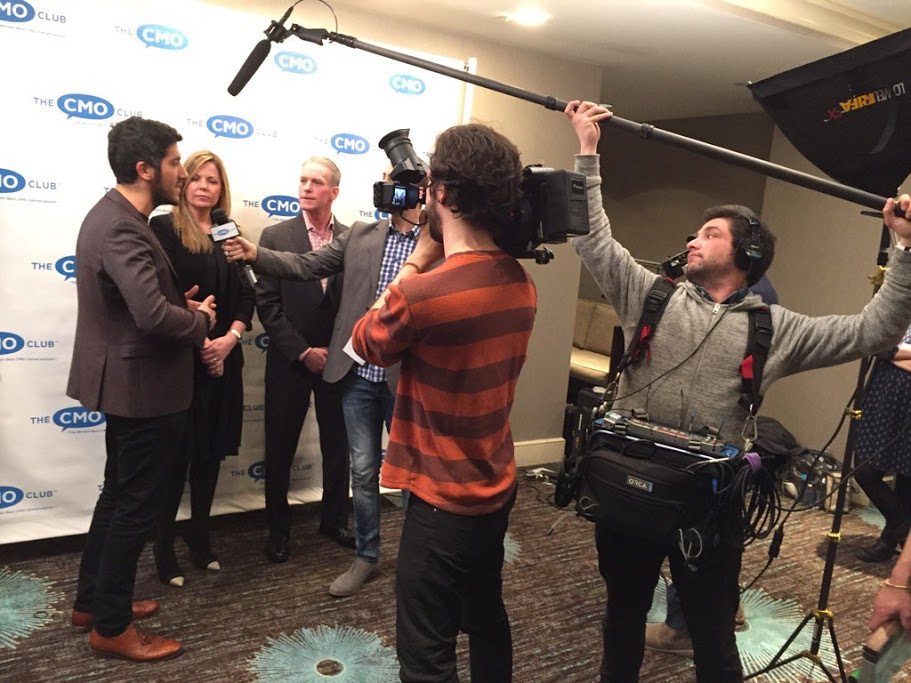
(Photo credit: Chris Zegal)
Marketers spend roughly $140 billion every year advertising online, a “digital” budget that is largely split between “search” and “banner” ads. But, as consumer behaviors continue to shift across new platforms and devices, how are brands assessing new marketing opportunities in areas such as social media, content distribution, and more?
Last week, over 150 senior marketing executives gathered in New York City’s Financial District for the 2016 CMO Club Spring Innovation and Inspiration Summit to find answers to questions such as this.
Keen to learn more about how the world’s leading brands are thinking about content marketing, Taboola’s founder and CEO — Adam Singolda — hosted a roundtable discussion on “Getting Your Brand Discovered — Ideas on Content Tools, Tips & Tricks,” with co-hosts Michael Donnelly (SVP, Global Digital Marketing, MasterCard) and Denise Karkos (CMO, TD Ameritrade).
The Rorschach Test: What is ‘Content Marketing’?
While content marketing has recently emerged as a buzz-worthy topic, many participants were skeptical about how the phrase is commonly used. For example, how does “content marketing” relate to “native advertising,” or a “brand as publisher” who has built a stand-alone media outlet?
Some executives in the room employed a broad definition, noting that “content marketing” could encompass any communication — internal or external — that a company produced. In this vein, social media messages, sales offers sent via email, events and branded experiences all fall under the “content marketing” umbrella. This POV ran counter to other executives, though, who had previously described their content marketing efforts as solely based around article or video creation and curation.
Another interesting blind spot for some was the vast amount of untapped user-generated content on platforms like Instagram and Pinterest. Given the authentic nature of such customer messages, communication strategies built around user-generated content might indeed be more effective than anything a brand could create themselves.
Content Marketing may not be new, but the ‘Pipes’ are.
A common rebuttal to arguments about the rise of content marketing is that the trend is nothing new. As far back as the early 20th century, companies like Michelin and John Deere published branded magazines, and advertorials shared the pages of leading magazines such as The New Yorker. But even if branded content creation is old news, the means for distributing that content to consumers are novel and more powerful than earlier-era marketers could have ever imagined.

(Photo credit: The CMO Club by Saans Photography)
Audience members discussed the growing importance of Facebook as a marketing channel, whose combination of scale and targeting capabilities have proved alluring for brands, generating over $16 billion a year from native in-feed promotions.
Discovery platforms like Taboola also offer a powerful way to share promoted stories through personalized recommendations in high-impact placements across the web. Such predictive channels have enabled innovative direct-to-consumer brands — including Blue Apron, Plated, and Dollar Shave Club — to educate consumers and scale their business in a way that search or display could never have supported.
Marketers who subscribe to the broader definition of “content marketing” mentioned that non-traditional media, such as smartphone home screens or messaging apps, will also become a powerful way for brands to engage with consumers.
All marketers agreed that these various content “pipes” were on the cusp of becoming significantly more actionable, with startups in cities such as San Francisco, New York, and Austin developing new technologies that can increasingly power true, real-time personalization and more accurately track and attribute user interactions throughout the marketing funnel and beyond.
Content Marketing Must Prove a Return Like any Other Channel.
For many in the audience, the most vexing aspect of the content marketing boom has been the number of companies investing resources in such initiatives without a clear indicator of what success might look like. Part of this challenge is the nature of content-driven initiatives, which often engage audiences at higher-stages of the marketing funnel. Efforts directed at high-intent environments like search are much easier to connect to sales and an overarching return-on-investment.
The word “conversion” surfaced as a key metric for many in the audience, but the exact definition varied depending on the context. Often it referred to new sales or purchases, but others noted that it could track contact acquisitions, email subscriptions, and newsletter sign-ups. Even more removed from the point-of-sale was the idea of “conversion” as a successful engagement with an influencer, which might then translate into higher brand awareness and new purchases amongst targeted audiences.
For campaigns that aren’t directly tied to sales, levels of engagement proved important in determining whether a particular effort succeeded. Many participants noted that social shares are a sought-after indicator that a piece of content resonated with an audience. Others mentioned metrics like time-on-site as a valuable barometer for how engaged a person was with an article or video.
Throughout the session, it became clear that there is still an accountability gap for too many content marketing efforts. Brands are assigning exploratory budgets to such initiatives, but in order for these campaigns to scale up in a way that could rival search or display spending, marketers must think strategically about how content-driven initiatives will drive consumer actions that provide tangible value for their overall business.
While it might seem obvious that a piece of content will resonate better with an audience than a disruptive banner ad, the entire industry — including marketers, agencies, platforms, and more — will have to work together to further build out the infrastructure and methodologies which can prove that such hunches are indeed the reality.